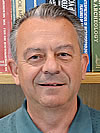
Panagiotis (Takis) Karkanas
Malcolm H. Wiener Laboratory for Archaeological Science
2017 Rip Rapp Archaeological Geology Award
Presented to Panagiotis (Takis) Karkanas
Citation by Paul Goldberg
This citation for Dr. Panagiotis (Takis) for the 2017 Rip Rapp Award is about one of the easiest “academic” tasks I’ve had to do in my career. It essentially writes itself. Takis brings a prodigious amount of breadth and depth to the field of geoarchaeology that is remarkable. One has only to look at his curriculum vitae and list of publications to be thoroughly impressed by his abilities and achievements.
Takis’ Ph.D. degree is in geology (mineralogy, petrology, and geochemistry), and shortly after he completed it he became interested in geoarchaeology, possibly around 1997 when he showed me thin sections from the Palaeolithic cave site of Theopetra. Since then he has continued to do geoarchaeology at numerous hunter and gatherer sites, from Greece, Israel, France, South Africa, China…. He has authored or co-authored more than 100 scientific papers the majority of which are in high-profile journals.
What makes Takis special among geoarchaeologists is his rather unique set of capabilities and approaches that can’t be found in many of the best practicing geoarchaeologists. These include:
- Detailed and significant field observations from a variety of contexts. These range from regional/landscape of site settings, geomorphology, structural geology, to microstratigraphic observations of individual layers; the above includes both hunter-gatherer sites as well as Classical and Bronze Age ones;
- Laboratory analyses and analytical aptitudes with a variety of techniques, such as micromorphology, FTIR, microprobe, and XRD. This is the payoff of having done a Ph.D. in metamorphic petrology.
- The facility of investigating sites of such differing ages, styles, types of deposits, and site formation processes, vacillating between geogenic to anthropogenic deposits.
- Promoting ethno-geo-archaeological research (carried out with colleagues and former students) on how mudbricks decay. As these object are so common in the Eastern Mediterranean, such baseline studies provide critical information about essential site formation processes.
After his beginning foray into “prehistoric” geoarchaeology, Takis has more recently switched geoarchaeological gears and has focused his energy (of which there is a lot) toward later, Holocene sites. His published papers on these later themes are landmark studies in the application of geoarchaeology to understanding past human activities at sites. They clearly demonstrate the notion that archaeological deposits are fundamental parts of the archaeological record on par with the traditional objects that are excavated.
About a year ago he moved to the American School of Classical Studies in Athens, where he is currently director of The Malcolm H. Wiener Laboratory for Archaeological Science. This move ensures that geoarchaeology will play a larger role in Mediterranean archaeology and geoarchaeology.
On a personal level, Takis is simply A1, and for me personally, one of the friendliest and most stimulating researchers I have worked with, regardless of discipline. He’s humble, modest, and simply a good friend, let along colleague. In short, I cannot think of a living geoarchaeologist who has such a vast array of credentials that befit the Rip Rapp Award of the GSA. He has made vast contributions to geoarchaeology, prehistory, and archaeology, both in research and in promoting archaeological science in general, particularly within later time periods such as classical studies.
 2017 George (Rip) Rapp Archaeological Geology Award — Response by Panagiotis (Takis) Karkanas
2017 George (Rip) Rapp Archaeological Geology Award — Response by Panagiotis (Takis) Karkanas
It is my honor to be the recipient of the 2017 Rip Rapp Archaeological Geology Award, and I sincerely regret not being able to join you at this year’s meeting. It is an even greater honor to be placed in such distinguished ranks as those of the past recipients who are leaders in the field.
I am a geologist by training, and only after finishing my Ph.D., did I start working in the field of archaeological geology. At that time my background was in mineralogy, petrography of metamorphic rocks, and geochemical processes. It was in 1994 when I was offered a part-time job in the Antiquity Service of Greece for doing geological assessment of some archaeological caves. I realized that there was a lot of potential to apply mineralogical and geochemical tools in solving archaeological problems. One of the first research projects that I got involved was the reconstruction of past chemical conditions in order to assess the completeness of the archaeological record. I found that authigenic minerals that are formed inside the sediment or soil can be used to determine whether primary anthropogenic constituents (bones, phytoliths, ash, chert, organic matter, charcoal, etc.) would have been affected by diagenesis. Through the years, I have expanded my research palette to include microscopy and micromorphology, as well as other sedimentary approaches to study archaeological deposits and site formation processes. I have been working in all cultural periods from the deep prehistory (early Palaeolithic) through Classical Archaeology into recent history, and have participated in several international research projects in many countries around the world, including South Africa, France, Spain, Israel, China, Albania, Hungary, and Cyprus.
I have to admit that this major change in my research interests has rewarded me with a rich and exciting career and has broadened my view of the discipline of geology as a whole. I see now that both disciplines can be enriched through the interaction of geology with archaeological issues that occur at any scale, from that of the continent down to the grains in a deposit or piece of pottery. I hope that my research can inspire upcoming generations of geologists who may consider straying from the traditional academic path and contribute to other disciplines with equal success. Science does not have practical boundaries.
